seats HONDA FIT 2010 2.G User Guide
[x] Cancel search | Manufacturer: HONDA, Model Year: 2010, Model line: FIT, Model: HONDA FIT 2010 2.GPages: 351, PDF Size: 5.67 MB
Page 31 of 351
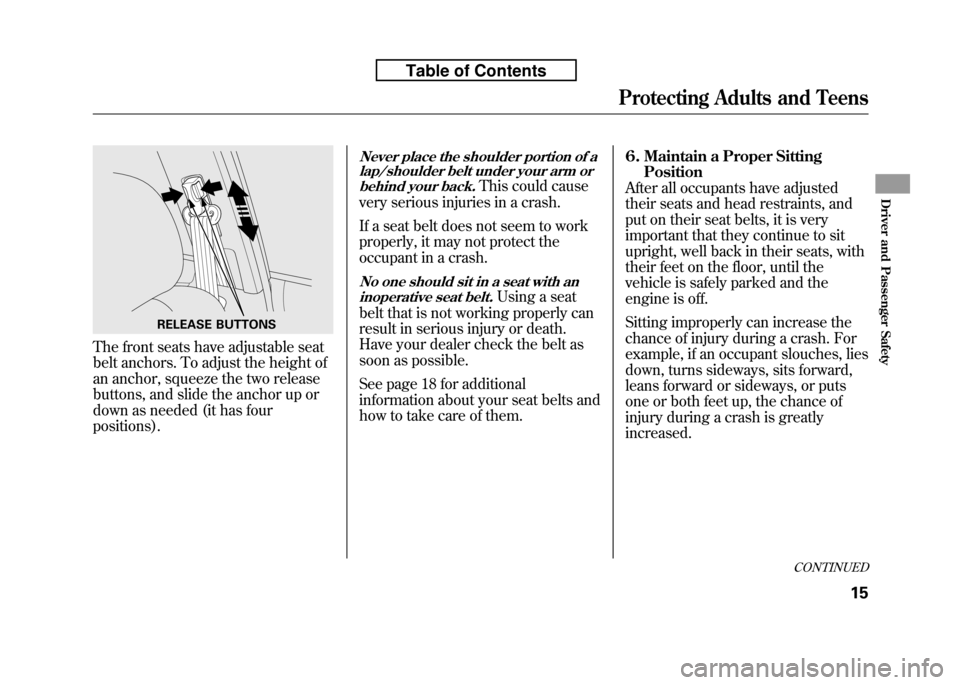
The front seats have adjustable seat
belt anchors. To adjust the height of
an anchor, squeeze the two release
buttons, and slide the anchor up or
down as needed (it has fourpositions).
Never place the shoulder portion of alap/shoulder belt under your arm or
behind your back.
This could cause
very serious injuries in a crash.
If a seat belt does not seem to work
properly, it may not protect the
occupant in a crash.
No one should sit in a seat with an inoperative seat belt.
Using a seat
belt that is not working properly can
result in serious injury or death.
Have your dealer check the belt as
soon as possible.
See page 18 for additional
information about your seat belts and
how to take care of them. 6. Maintain a Proper Sitting
Position
After all occupants have adjusted
their seats and head restraints, and
put on their seat belts, it is very
important that they continue to sit
upright, well back in their seats, with
their feet on the floor, until the
vehicle is safely parked and the
engine is off.
Sitting improperly can increase the
chance of injury during a crash. For
example, if an occupant slouches, lies
down, turns sideways, sits forward,
leans forward or sideways, or puts
one or both feet up, the chance of
injury during a crash is greatlyincreased.
RELEASE BUTTONS
CONTINUED
Protecting Adults and Teens
15
Driver and Passenger Safety
Table of Contents
Page 33 of 351

Additional Safety Precautions●
Never let passengers ride in the
cargo area or on top of a folded-
down back seat.
If they do, they
could be very seriously injured in a crash.
●
Never let passengers ride in the area in front of a folded-up rearseat or on top of a folded-down rear
seat.
If they do, they could be very
seriously injured in a crash.
●
Passengers should not stand up or change seats while the vehicle is
moving.
A passenger who is not
wearing a seat belt during a crash
or emergency stop can be thrown
against the inside of the vehicle,
against other occupants, or out of
the vehicle.
●
Two people should never use the same seat belt.
If they do, they
could be very seriously injured in acrash. ●
Do not put any accessories on seat
belts.
Devices intended to improve
occupant comfort or reposition the
shoulder part of a seat belt can
reduce the protective capability of
the belt and increase the chance of
serious injury in a crash.
●
Do not place hard or sharp objects between yourself and a front
airbag.
Carrying hard or sharp
objects on your lap, or driving with
a pipe or other sharp object in your
mouth, can result in injuries if your
front airbag inflates.
●
Keep your hands and arms away from the airbag covers.
If your
hands or arms are close to an
airbag cover, they could be injured
if the airbag inflates. ●
Do not attach or place objects on
the front airbag covers.
Objects on
the covers marked ‘‘SRS AIRBAG ’’
could interfere with the proper
operation of the airbags or be
propelled inside the vehicle and
hurt someone if the airbags inflate.
●
Do not attach hard objects on or near a door.
If a side airbag or a
side curtain airbag inflates, a cup
holder or other hard object
attached on or near the door could
be propelled inside the vehicle and
hurt someone.
●
Do not cover or replace front seat- back covers without consulting
your dealer.
Improperly replacing
or covering front seat-back covers
can prevent your side airbags from
inflating during a side impact.
Protecting Adults and Teens
17
Driver and Passenger Safety
Table of Contents
Page 43 of 351
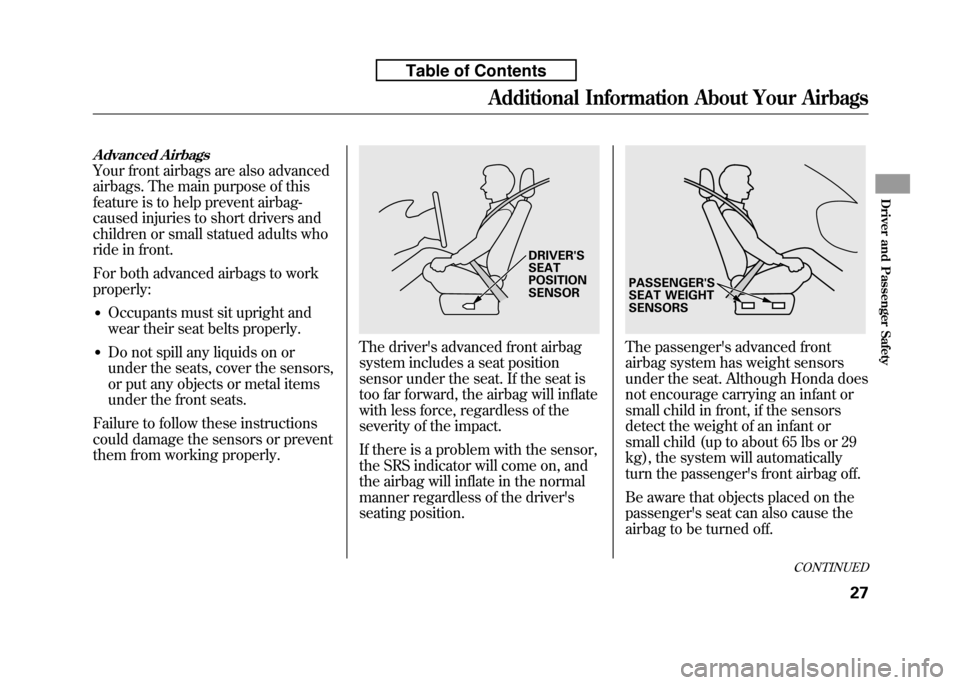
Advanced Airbags
Your front airbags are also advanced
airbags. The main purpose of this
feature is to help prevent airbag-
caused injuries to short drivers and
children or small statued adults who
ride in front.
For both advanced airbags to work properly:● Occupants must sit upright and
wear their seat belts properly.
● Do not spill any liquids on or
under the seats, cover the sensors,
or put any objects or metal items
under the front seats.
Failure to follow these instructions
could damage the sensors or prevent
them from working properly.
The driver's advanced front airbag
system includes a seat position
sensor under the seat. If the seat is
too far forward, the airbag will inflate
with less force, regardless of the
severity of the impact.
If there is a problem with the sensor,
the SRS indicator will come on, and
the airbag will inflate in the normal
manner regardless of the driver's
seating position.The passenger's advanced front
airbag system has weight sensors
under the seat. Although Honda does
not encourage carrying an infant or
small child in front, if the sensors
detect the weight of an infant or
small child (up to about 65 lbs or 29
kg), the system will automatically
turn the passenger's front airbag off.
Be aware that objects placed on the
passenger's seat can also cause the
airbag to be turned off.
DRIVER'S SEAT POSITION SENSOR
PASSENGER'S
SEAT WEIGHT
SENSORS
CONTINUED
Additional Information About Your Airbags
27
Driver and Passenger Safety
Table of Contents
Page 45 of 351

Only one airbag will deploy during a
side impact. If the impact is on the
passenger's side, the passenger's
side airbag will deploy even if there
is no passenger.
To get the best protection from the
side airbags, front seat occupants
should wear their seat belts and sit
upright and well back in their seats.Side Airbag Cutoff System
Your vehicle has a side airbag cutoff
system designed primarily to protect
a child riding in the front passenger'sseat.
Although Honda does not encourage
children to ride in front, if the
position sensors detect a child has
leaned into the side airbag's
deployment path, the airbag will shutoff.
The side airbag may also shut off if a
short adult leans sideways, or a
larger adult slouches and leans
sideways into the airbag's
deployment path.
Objects placed on the front
passenger seat can also cause the
side airbag to be shut off.If the side airbag off indicator comes
on (see page 31), have the passenger
sit upright. Once the passenger is
out of the airbag's deployment path,
the system will turn the airbag back
on, and the indicator will go out.
There will be some delay between
the moment the passenger moves
into or out of the airbag deployment
path and when the indicator comes
on or goes off.
A front seat passenger should not
use a cushion or another object as a
backrest. It may prevent the cutoff
system from working properly.
Additional Information About Your Airbags
29
Driver and Passenger Safety
Table of Contents
Page 46 of 351
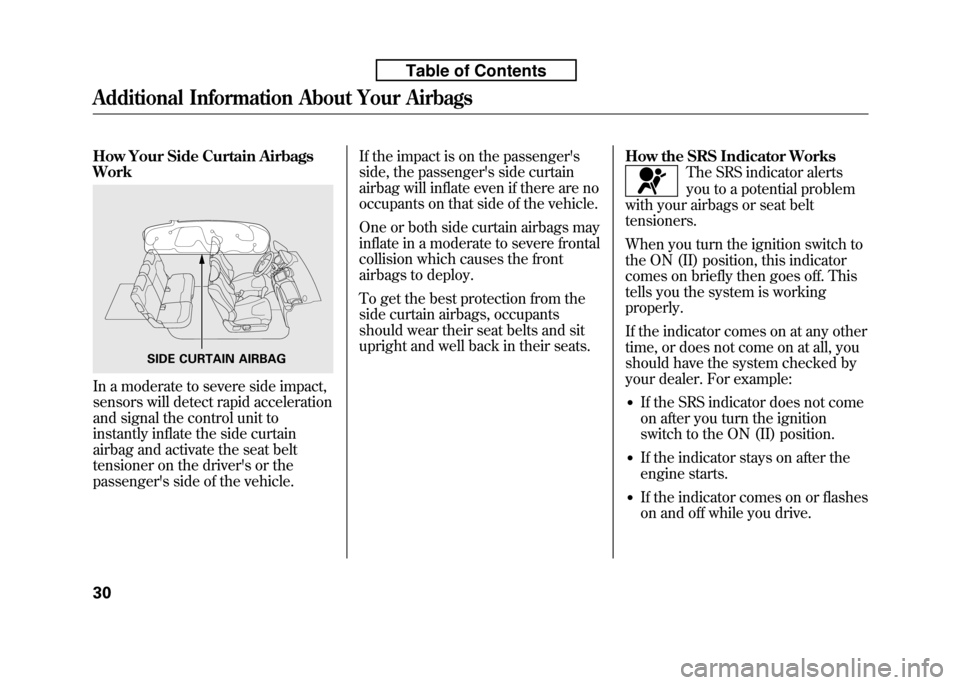
How Your Side Curtain Airbags Work
In a moderate to severe side impact,
sensors will detect rapid acceleration
and signal the control unit to
instantly inflate the side curtain
airbag and activate the seat belt
tensioner on the driver's or the
passenger's side of the vehicle.If the impact is on the passenger's
side, the passenger's side curtain
airbag will inflate even if there are no
occupants on that side of the vehicle.
One or both side curtain airbags may
inflate in a moderate to severe frontal
collision which causes the front
airbags to deploy.
To get the best protection from the
side curtain airbags, occupants
should wear their seat belts and sit
upright and well back in their seats.
How the SRS Indicator Works
The SRS indicator alerts
you to a potential problem
with your airbags or seat belt tensioners.
When you turn the ignition switch to
the ON (II) position, this indicator
comes on briefly then goes off. This
tells you the system is workingproperly.
If the indicator comes on at any other
time, or does not come on at all, you
should have the system checked by
your dealer. For example:
● If the SRS indicator does not come
on after you turn the ignition
switch to the ON (II) position.
● If the indicator stays on after the
engine starts.
● If the indicator comes on or flashes
on and off while you drive.
SIDE CURTAIN AIRBAG
Additional Information About Your Airbags
30
Table of Contents
Page 51 of 351

All Children Should Sit in a Back Seat
According to accident statistics,
children of all ages and sizes are
safer when they are restrained in a
back seat.
The National Highway Traffic Safety
Administration and Transport
Canada recommend that all children
aged 12 and under be properly
restrained in a back seat. Some
states have laws restricting where
children may ride.
Children who ride in back are less
likely to be injured by striking
interior vehicle parts during a
collision or hard braking. Also,
children cannot be injured by an
inflating front airbag when they ride
in the back.The Passenger's Front Airbag Can
Pose Serious Risks
Front airbags have been designed to
help protect adults in a moderate to
severe frontal collision. To do this,
the passenger's front airbag is quite
large, and it can inflate with enough
force to cause very serious injuries.
Even though your vehicle has an
advanced front airbag system that
automatically turns the passenger's
front airbag off under certain
circumstances (see page 31), please
follow these guidelines:
Infants
Never put a rear-facing child seat inthe front seat of a vehicle equipped
with a passenger's front airbag.
If the
airbag inflates, it can hit the back of
the child seat with enough force to
kill or very seriously injure an infant.
Small Children
Placing a forward-facing child seat inthe front seat of a vehicle equippedwith a passenger's front airbag can be
hazardous.
If the vehicle seat is too
far forward, or the child's head is
thrown forward during a collision, an
inflating front airbag can strike the
child with enough force to kill or
very seriously injure a small child.
Larger Children
Children who have outgrown childseats are also at risk of being injuredor killed by an inflating passenger's
front airbag.
Whenever possible,
larger children should sit in the back
seat, on a booster seat if needed, and
be properly restrained with a seat
belt (see page 49 for important
information about protecting largerchildren).
CONTINUED
Protecting Children -General Guidelines
35
Driver and Passenger Safety
Table of Contents
Page 55 of 351
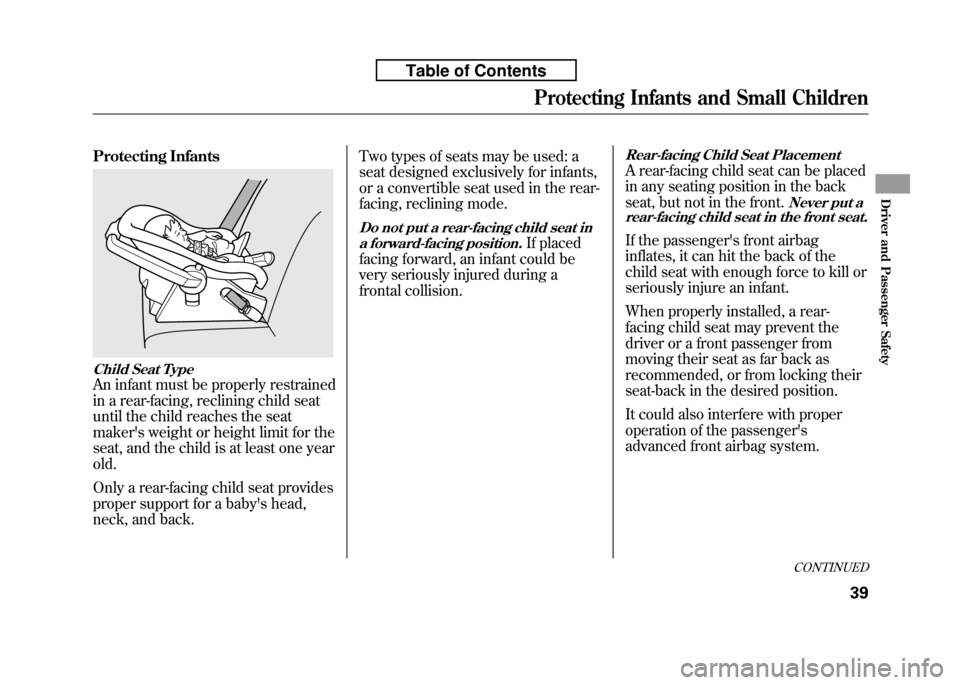
Protecting Infants
Child Seat Type
An infant must be properly restrained
in a rear-facing, reclining child seat
until the child reaches the seat
maker's weight or height limit for the
seat, and the child is at least one yearold.
Only a rear-facing child seat provides
proper support for a baby's head,
neck, and back.Two types of seats may be used: a
seat designed exclusively for infants,
or a convertible seat used in the rear-
facing, reclining mode.
Do not put a rear-facing child seat in
a forward-facing position.
If placed
facing forward, an infant could be
very seriously injured during a
frontal collision.
Rear-facing Child Seat Placement
A rear-facing child seat can be placed
in any seating position in the back
seat, but not in the front.
Never put a
rear-facing child seat in the front seat.
If the passenger's front airbag
inflates, it can hit the back of the
child seat with enough force to kill or
seriously injure an infant.
When properly installed, a rear-
facing child seat may prevent the
driver or a front passenger from
moving their seat as far back as
recommended, or from locking their
seat-back in the desired position.
It could also interfere with proper
operation of the passenger's
advanced front airbag system.
CONTINUED
Protecting Infants and Small Children
39
Driver and Passenger Safety
Table of Contents
Page 56 of 351
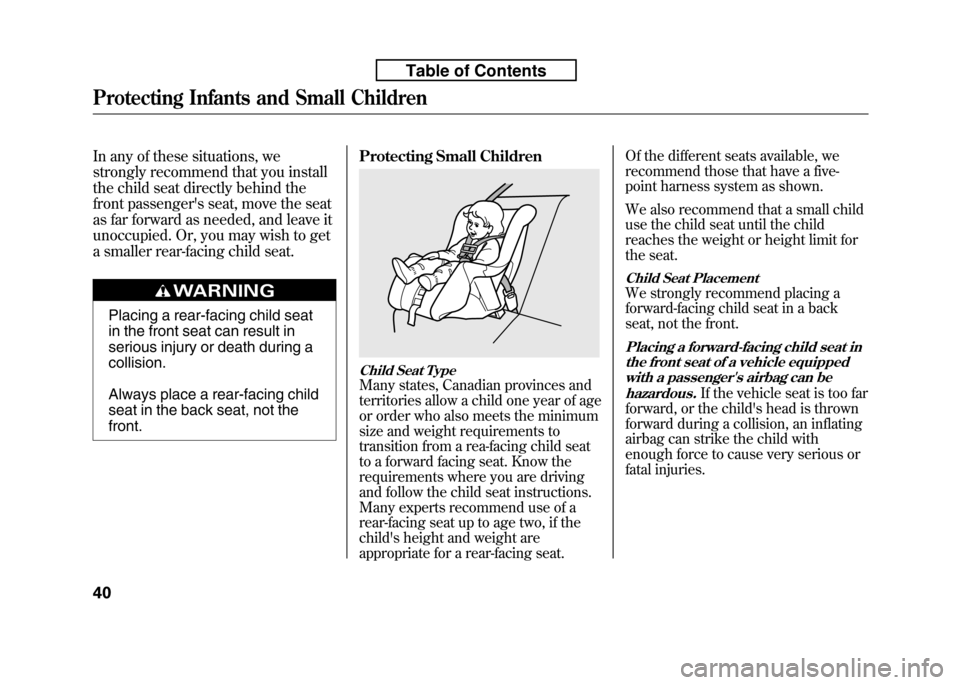
In any of these situations, we
strongly recommend that you install
the child seat directly behind the
front passenger's seat, move the seat
as far forward as needed, and leave it
unoccupied. Or, you may wish to get
a smaller rear-facing child seat.
Placing a rear-facing child seat
in the front seat can result in
serious injury or death during acollision.
Always place a rear-facing child
seat in the back seat, not thefront.Protecting Small Children
Child Seat Type
Many states, Canadian provinces and
territories allow a child one year of age
or order who also meets the minimum
size and weight requirements to
transition from a rea-facing child seat
to a forward facing seat. Know the
requirements where you are driving
and follow the child seat instructions.
Many experts recommend use of a
rear-facing seat up to age two, if the
child's height and weight are
appropriate for a rear-facing seat. Of the different seats available, we
recommend those that have a five-
point harness system as shown.
We also recommend that a small child
use the child seat until the child
reaches the weight or height limit for
the seat.
Child Seat Placement
We strongly recommend placing a
forward-facing child seat in a back
seat, not the front.
Placing a forward-facing child seat in
the front seat of a vehicle equipped
with a passenger's airbag can be
hazardous.
If the vehicle seat is too far
forward, or the child's head is thrown
forward during a collision, an inflating
airbag can strike the child with
enough force to cause very serious or
fatal injuries.
Protecting Infants and Small Children
40
Table of Contents
Page 57 of 351
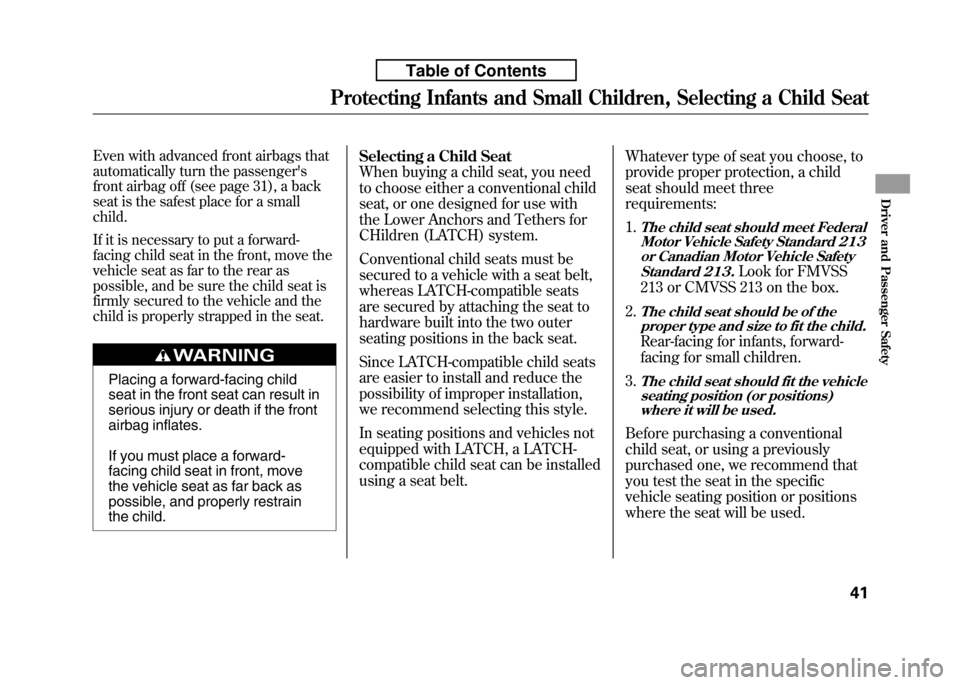
Even with advanced front airbags that
automatically turn the passenger's
front airbag off (see page 31), a back
seat is the safest place for a small child.
If it is necessary to put a forward-
facing child seat in the front, move the
vehicle seat as far to the rear as
possible, and be sure the child seat is
firmly secured to the vehicle and the
child is properly strapped in the seat.
Placing a forward-facing child
seat in the front seat can result in
serious injury or death if the front
airbag inflates.
If you must place a forward-
facing child seat in front, move
the vehicle seat as far back as
possible, and properly restrain
the child.Selecting a Child Seat
When buying a child seat, you need
to choose either a conventional child
seat, or one designed for use with
the Lower Anchors and Tethers for
CHildren (LATCH) system.
Conventional child seats must be
secured to a vehicle with a seat belt,
whereas LATCH-compatible seats
are secured by attaching the seat to
hardware built into the two outer
seating positions in the back seat.
Since LATCH-compatible child seats
are easier to install and reduce the
possibility of improper installation,
we recommend selecting this style.
In seating positions and vehicles not
equipped with LATCH, a LATCH-
compatible child seat can be installed
using a seat belt.
Whatever type of seat you choose, to
provide proper protection, a child
seat should meet threerequirements: 1.
The child seat should meet Federal
Motor Vehicle Safety Standard 213
or Canadian Motor Vehicle Safety
Standard 213.
Look for FMVSS
213 or CMVSS 213 on the box.
2.
The child seat should be of the proper type and size to fit the child.
Rear-facing for infants, forward-
facing for small children.
3.
The child seat should fit the vehicle seating position (or positions)where it will be used.
Before purchasing a conventional
child seat, or using a previously
purchased one, we recommend that
you test the seat in the specific
vehicle seating position or positions
where the seat will be used.
Protecting Infants and Small Children, Selecting a Child Seat
41
Driver and Passenger Safety
Table of Contents
Page 58 of 351

After selecting a proper child seat
and a good place to install the seat,
there are three main steps in
installing the seat: 1.
Properly secure the child seat tothe vehicle.
All child seats must be
secured to the vehicle with the lap
part of a lap/shoulder belt or with
the LATCH (Lower Anchors and
Tethers for CHildren) system. A
child whose seat is not properly
secured to the vehicle can be
endangered in a crash.
2.
Make sure the child seat is firmly secured.
After installing a child
seat, push and pull the seat
forward and from side-to-side to
verify that it is secure. A child seat secured with a seat
belt should be installed as firmly
as possible. However, it does not
need to be
‘‘rock solid. ’’Some side-
to-side movement can be expected
and should not reduce the child
seat's effectiveness.
If the child seat is not secure, try
installing it in a different seating
position, or use a different style of
child seat that can be firmlysecured. 3.
Secure the child in the child seat.
Make sure the child is properly
strapped in the child seat
according to the child seat maker's
instructions. A child who is not
properly secured in a child seat
can be seriously injured in a crash.
The following pages provide
guidelines on how to properly install
a child seat. A forward-facing child
seat is used in all examples, but the
instructions are the same for rear-
facing child seats.
Installing a Child Seat
42
Table of Contents